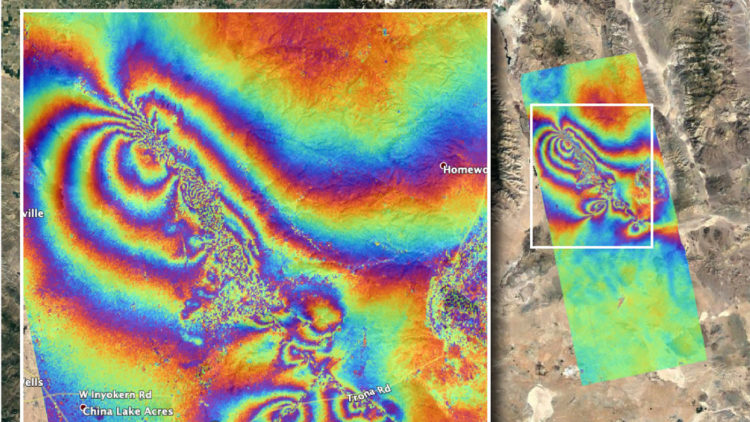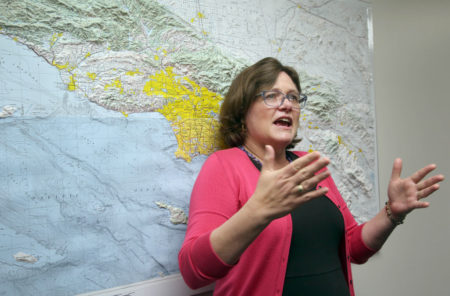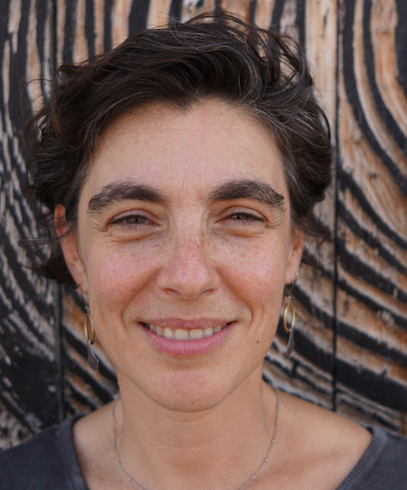
Satellite imaging of a 2019 earthquake in southern California
Jones is something of a celebrity seismologist (how many of those do you know?) with an outsized love of earthquakes. She is 100-percent certain that The Big One is coming to southern California, more specifically to the San Andreas Fault. During a guest appearance on “Conan” in 2016, she confessed more than a smidge of disappointment that the overdue quake hadn’t happened in her decades-long watch as a scientist at the U.S. Geological Survey. Then she left O’Brien agape with this: “I’m down to hoping I just live to see it.”
That kind of straight talk has earned Jones deep cred among journalists, policy-makers and the public for her ability to make sense of the risks we face in an earthquake, and how we might mitigate and prepare for them. (She told O’Brien that she keeps tennis shoes, eyeglasses and keys tucked under her bed. And yes, she has earthquake insurance.)
The articulations of science can be confusing. As we’ve seen in response to climate change and Covid, scientific findings are sometimes met with skepticism or downright rejection — denial that just deepens the risks. That’s in part, Jones says, the fault of scientists, who “are very bad storytellers in general.” They are trained to stick to the data, and to “explicitly reject” the act of telling the stories suggested by that data. But compelling storytelling is crucial for conveying the outlines of an emergency, and getting the public and policy makers to take appropriate actions.

Dr. Lucy Jones
Jones has increasingly come to inhabit this alchemical zone of science as story. In 2008, her office created a gripping what-if narrative, “The Great California ShakeOut,” describing the fallout of a magnitude 7.8 quake on the southern San Andreas Fault. It is used around the world as part of earthquake preparedness efforts.
Jones left government service in 2016 to create the Dr Lucy Jones Center for Science and Society, Now she trains other scientists in approaches that can help highlight the public importance of their work — a process she calls “science activation.” Interest is intense, she says: “We’re seeing a really big social shift as scientists start to recognize that they can’t afford to stay in the ivory tower.”
Jones also has experimented with storytelling through non-verbal means. As a life-long musician, “I sometimes hear the data,” Jones writes on her website. Last year, she created a Baroque composition for strings that sets the rise in the Earth’s temperature since 1880 to music. “This data is like a graceful minuet accelerating into a frantic jog,” she writes.
She recently launched a new podcast, “Getting Through It,” about navigating disasters, including Covid-19. She came up with a memorable catchphrase — “Don’t share your air” — to explain in four one-syllable words exactly why we should all be wearing masks.
As a journalist who is forever seeking clarity in the stories of science, I was intrigued, so reached out to Jones. We talked about why scientists have been so resistant to storytelling, what makes a message stick in a crisis, and the narrative power of music. Our interview has been edited for length and clarity.
“Don’t share your air.” There’s a wicked punch to the clarity of that one-liner. Where did it come from?
I tend to speak in sound bites. We live in a really complex world, and figuring out the one piece that really matters — that’s sort of a skill. Reporters covering earthquakes loved me because they didn’t have to paraphrase me. “Don’t share your air” just came out that way when I was trying to explain the fundamental issues involved in protecting ourselves from Covid: Don’t breathe in the air breathed out by an infectious person, look at how being indoors matters, how wearing a mask matters.
How do you think about crafting a message that effectively conveys complicated scientific information?
I’ve been successful in public communication by not assuming that people are too stupid to understand what I mean. I have to look for the words that go to a simple place to explain something, and when I can find that simple place, people believe it more.
I’ve also done a lot of research on crisis messaging, and I’ve collaborated with other researchers, such as Deanna Sellnow and Timothy Sellnow at the University of Central Florida. They use what they call the IDEA model to create actionable messaging in crises. The “I” stands for internalization: You have to get people to believe that this message applies to them. Most people who die of COVID-19 are old, so many young people don’t think it does. The “D is distribution: the more sources that give the same message, the more effective it is. The E is for education: Why it matters, which includes science. And then the A is for action: Telling people clearly what to do. Pretty much all the messaging about masks has been opposite to this framework.
How did you go from being a straight-up academic scientist to being more of a risk and disaster communicator?
I’m a seismologist by training. I research how waves move through the ground. When one earthquake happens, another one’s more likely. Mostly they’re smaller and we call them aftershocks, but we also get foreshocks, clusters and other phenomena. Quantifying those relationships gives us actionable information. Doing that research put me in the position of talking with people (in public policy) who would be using this information.
As my career evolved from doing pure science to being near that policy interface, I saw how much of the basic science that’s taught in first-year college classes wasn’t widely known. You’ve got emergency managers and utility operators and local government officials who are making policy decisions about earthquakes without knowing stuff that’s settled fact. In the early 2000s, when I was on a state seismic safety commission, I discovered how much policy was being made with absolutely no knowledge of what earthquakes actually did. That moved me to be much more active in the public realm.
And it showed me that there’s this divide between academic researchers, who are creating new science, and policymakers, who should be making decisions using science. Policymakers shouldn’t be using cutting-edge science, because it’s not settled yet. But by the time the science is settled enough to be used in policy, we’re not talking about it anymore, because we don’t fund or value explaining science that’s not cutting edge.
It does seem that there’s an especially strong need these days for scientists to communicate their work, or to work closely with people who can.
Yes. But it’s a complicated place. Scientists often want to say, “My job is to tell you what’s true, and your job is to decide what to do about it.” They are often so afraid of stepping into policy that they won’t do the science that shows the implications of policy decisions. To make sure policymakers understand the implications of their decisions, scientists need to be doing research that’s right at the edge of policy. That is a murky place, and we have catered to peoples’ comfort zones by leaving it unpopulated.
This actually feels like a place for story, where you have to paint the picture of what’s going to happen if, as a society, we take one step versus another.
Yes, which points to another tension with the scientific community. As scientists, we are trained to be suspicious of stories because we know that stories can mislead you. They don’t tell you whether something’s true; they tell you what you believe, or what you feel. As scientists like to say, the plural of anecdote is not data.
But once we’ve ripped something apart to be able to say whether it’s true or not, once it has reached consensus, we’ve got to go back to the story to communicate it.
With the SARS-CoV-2 pandemic, unlike with earthquakes, we can’t wait for scientific consensus. But apart from that, what would you say is similar and what’s different in the scientific messaging required to get people through these two types of emergencies?
Oh, my God, it’s so much the same thing. In 2018 I wrote a book, called “The Big Ones: How Natural Disasters Have Shaped Us (And What We Can Do About Them).” Each chapter tells the story of a different catastrophic disaster. I defined the “big ones” as the ones that changed the society that they hit. The Northridge earthquake in Los Angeles wasn’t really a big one; we picked up and recovered afterwards. But the 1906 earthquake in San Francisco was, because it ended San Francisco’s reign as the economic powerhouse of the West Coast. As was the Lisbon earthquake in 1755. Lisbon was the fourth-largest city in Europe, fabulously wealthy with all the gold coming in from Brazil, but after it, Portugal was never again a world power.
This pandemic is a catastrophic disaster by any measure — the number of people dead, the economic disruption. We jumped to recovery before we were out of the acute phase, and actually we were never really willing to shut down, partly because we have had such conflicting messaging on whether or not it was needed. And we didn’t all pitch in, like they did in New Zealand.
On a more personal level, what does story mean to you? What kinds of stories do you seek out, as a consumer and a creator?
I’m a science fiction/fantasy person. My father introduced me to it at a young age. I love escaping reality, I guess! I read “The Lord of The Rings” a half dozen times before I was 15. As I get older, though, I find I am losing my connection to that type of stuff.
When I wrote my book, I had to learn how to be a storyteller. I loved researching the history and conveying the science through peoples’ stories. It was a really interesting process. It was hard, actually, to use imagery. I was writing something about candles falling in a church, because there was an earthquake that happened in the middle of a mass in Lisbon and ended up burning down the city — but I don’t know how that happened. But I enjoyed writing it so much that I’m trying to figure out how to do another one.
And then there’s music. It’s a tradition in my family: You retire from your lucrative job to become a full-time musician. I play a rather esoteric classical music, and I’ve been discovering the stories within it. I’m studying with someone who is one of the most emotionally demonstrative players in my genre. There’s a passage from St John’s Passion — where the viola da gamba, my instrument, plays the part as Jesus dies. My teacher said, “Think of those grace notes resolving into this really dissonant cord as the nails ripping farther up through the flesh.”
The idea that you can use music to express that type of emotion is a new place for me. I was never a good enough musician to get beyond trying to technically manage what I was doing. Now, I’ve had enough time to feel more comfortable in the technical space, and start thinking about what the story is that I’m trying to tell. That’s a mind-blowing place for me.
Alla Katsnelson is a science writer and editor in western Massachusetts who covers the life sciences and health. Her work has appeared in Nature, BBC Focus, the New York Times, C&EN, and other outlets.


